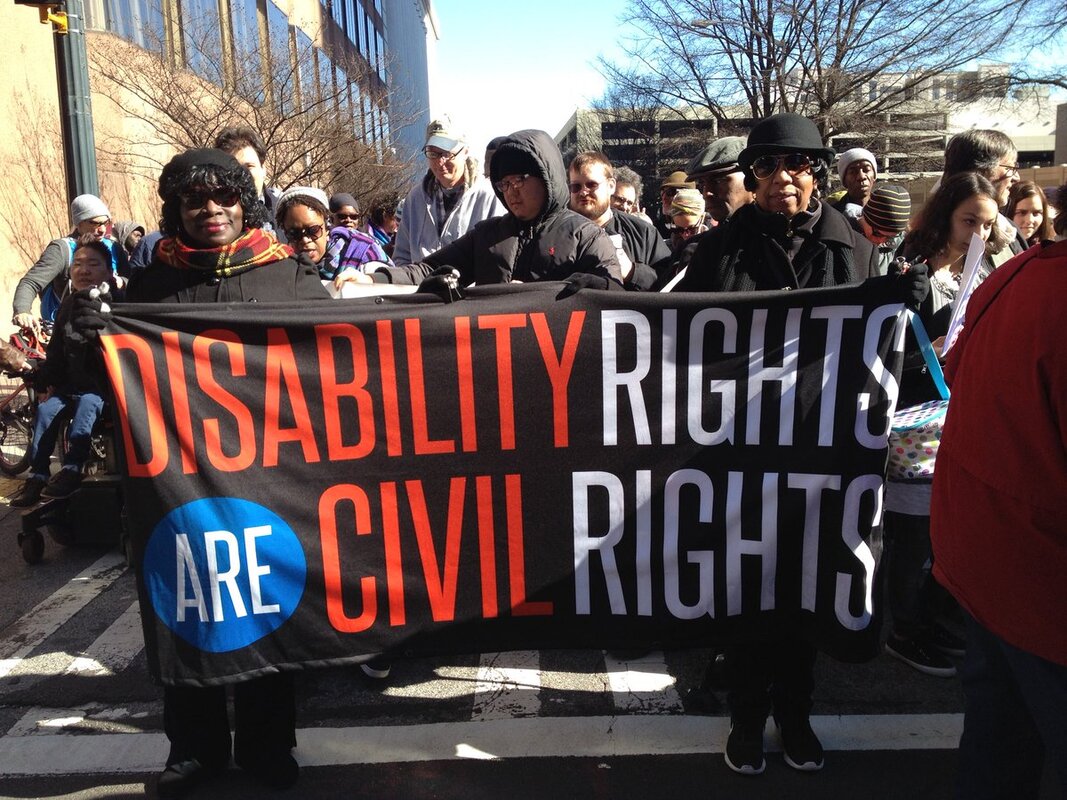MINNESOTA'S JENSEN CASE -- ENFORCING OLMSTEAD |
A Fantastic Resource
|
Minnesota Resistance to Precision & Measurable Goals in its Olmstead Plan -- Fed. Ct. Enforcement
|
"For the second time in eight months, a federal judge has rebuked the state of Minnesota over its plan to modernize services for thousands of residents with disabilities, threatening court sanctions if the state fails to improve its performance. "In a blunt ruling issued Wednesday, U.S. District Judge Donovan Frank said the state's revised blueprint — known as an Olmstead plan — failed to meet his earlier demands for precision and measurable goals. "The 158-page plan, nearly three years in the making and crafted with input from eight state agencies, has been revised three times without passing court muster." It does say a lot about a society regarding who has the right to get ANGRY and who doesn't.
On the other hand, the point really isn't to get angry. With respect to Olmstead, elected and appointed Federal Enforcers & State Officials are pretty uniform in how much THEY LOVE OLMSTEAD -- they just have a really hard time complying with it. We must be able to address the WIDESPREAD NON-COMPLIANCE across the US and in Colorado openly and creatively. OLMSTEAD is about MORAL COURAGE in large measure because it is a HUGE RESOURCE CHALLENGE and a HUGE CONCEPTUAL CHALLENGE for the SOCIETY & OFFICIALS about how we get there. If States were supposed to comply 20 years ago -- getting on track for OLMSTEAD COMPLIANCE by the END OF THE CENTURY -- really doesn't cut it. We get that with CORONAVIRUS -- we don't get it with COGNITIVE DISABILITY even though we're surrounded by the EVIDENCE-- the Broken Lives and the Ones that have gone on. |
Will It Take Additional Lawsuits for Other States & Colorado to Comply with Olmstead -- IT COULD
Enforcement of the Jensen Settlement Agreement
The Key to Olmstead Compliance in Minnesota
|
Your browser does not support viewing this document. Click here to download the document.
|
Your browser does not support viewing this document. Click here to download the document.
Selected Topic Areas of the Settlement Agreement:
B. Olmstead Plan Within sixty (60) days of the Court's approval of this Agreement, the Department will establish an Olmstead Planning Committee which will issue its public recommendations within ten (10) months of the Court's Order approving this Agreement. Within eighteen (18) months of the Court's approval of this Agreement, the State and the Department shall develop and implement a comprehensive Olmstead plan that uses measurable goals to increase the number of people with disabilities receiving services ' that best meet their individual needs and in the "Most Integrated Setting," and is consistent and in accord with the U.S. Supreme Court' s decision in Olmstead v. L.C., 527 u.s. 582 (1999). 2. The Olmstead Planning Committee must be comprised of no less than fifteen (15) members with demonstrated understanding of the spirit and intent of the Olmstead decision, best practices in the field of disabilities, and a longstanding commitment to systemic change that respects the human and civil rights of people with disabilities. |
Some More on Minnesota's Jensen Case -- Where Olmstead Compliance Became a Reality
|
Your browser does not support viewing this document. Click here to download the document.
What's interesting about Minnesota's Landmark Jensen Case is that it is really the SETTLEMENT AGREEMENT that set the stage for Olmstead Enforcement & Compliance -- which has been so out of reach for people with disabilities.
It's also important that this AMENDED COMPLAINT led to the Settlement Agreement. JENSEN:
|
Via Civil Rights Litigation Clearinghouse
On Sept. 18, 2014, the Court declined to adopt the state's proposed Olmstead Plan and ordered that they submit a revised plan. The state then submitted another revised Olmstead Plan, for which Judge Frank gave his provisional approval on January 9, 2015. However, the court's order outlined a number deficiencies in the proposed Plan, particularly with respect to the state's plans for reaching its employment, housing, and healthcare goals. To address these deficiencies, Judge Frank ordered the state to include more specificity and concrete action steps in its plan. After the State submitted a revised plan in March of 2015, on April 14, the Independent Monitor submitted a special report to the court detailing his concerns about potential misrepresentations and inaccurate or unverified reporting on behalf of the State with respect to its progress. For instance, an April 2014 report filed by the State indicated that "mobile support teams" were actively supporting class members in their homes. However, when the Monitor asked DHS about the activities of these teams, he was told the teams did not exist. The State disputed knowingly or intentionally filing inaccurate information. Judge Frank declined to impose sanctions or hold the state in contempt of court, but did reject the state's revised Olmstead Plan on May 6, 2015. 2015 WL 2100942. He again ordered the state to submit a revised plan, this time by July 10. On May 27, 2015, DHS filed a motion for relief from judgment, asking the court to exempt the State from the provision of the Settlement Agreement that prohibited "transfers or placements of persons committed solely as a person with a developmental disability to the Minnesota Security Hospital." The State apparently did so in response to its decision to move a 16-year-old with developmental disabilities to the Minnesota Security Hospital. On June 24, Judge Frank denied the motion and ordered the defendants to create a discharge plan for the juvenile who had been moved to the hospital. (This individual was moved to a community placement, with approval of the court, in July of 2016.) On August 10, 2015, the State submitted another revised Olmstead Plan. The State's letter to the court indicates that it focused not only on what actions state parties would take to implement the Plan, but also on creating concrete and measurable goals. Although plaintiffs still disapproved of certain aspects of the proposed Olmstead Plan, the court approved it on September 29, 2015. Judge Frank found that three key changes influenced his decision to approve of the Plan: (1) the addition of concrete baseline data and specific timelines to establish measurable goals; (2) improvements to each goal that make the Olmstead Plan not only measurable, but strategically tailored to make a significant impact in the lives of individuals with disabilities across the state; and (3) added commitments to make the Olmstead Plan an evolving document that will continue to respond to the changing needs of individuals in the state over time. The plan included over 100 Evaluation Criteria (EC) through which the State could measure its progress. At this time, two areas - Assistive Technology and Preventing Abuse and Neglect - remained "under development." The court gave defendants another to develop these topic areas while it began to implement the overall Plan. On November 20, 2015, Judge Frank awarded $50,000 in additional attorneys' fees to Class Counsel. On February 22, 2016, the court issued two orders with respect to the State's reporting requirements. One required that DHS submit quarterly and annual reports regarding implementation of the newly-approved Olmstead Plan. That order also extended the court's jurisdiction through December of 2019. The second order required DHS to submit semi-annual and annual Comprehensive Plan of Action (CPA) reports regarding implementation of the Settlement Agreement. The orders temporarily stayed the reporting duties of the Court Monitor. On May 31, 2016, DHS submitted a revised Olmstead Plan, which incorporated developed plans for the areas of Assistive Technology and Preventing Abuse and Neglect. After DHS filed its next round of reports in August, the court ordered the Monitor to write an independent Compliance Report. The Compliance Report, dated November 29, 2016, indicated that defendants had improved in the thoroughness of their self-reporting. However, it noted several areas for improvement in reporting, including verification of outcomes related to quality-of-life, looking outside the scope of documents for sources of compliance information, and including information verifying how "best efforts" were made where that standard was required. Substantively, the Monitor noted that lack of community support services continued to hamper outcomes related to successful transitions into the community. It also noted areas of significant progress, including the cessation of the use of restraints in some facilities and the development of extensive community training. The annual CPA for the year 2016 was filed under seal on March 31, 2017, so its contents are not accessible. However, a quarterly report filed on February 28 indicated that the State had met certain annual goals, including increasing the number of individuals in integrated employment settings, increasing the number of students receiving education in the most integrated setting, and increasing the number of accessible pedestrian signals. It also highlighted areas for improvement, including increasing the number of students entering post-secondary education and decreasing the number of students experiencing the use of emergency restrictive procedures. In April of 2017, defendants objected - but did not formally make a motion - to the court's continuing jurisdiction, arguing that it could only extend its jurisdiction for one year beyond the original two-years that the court indicated it would retain jurisdiction after the Settlement Agreement was approved in 2011. Judge Frank denied defendants' objection on the basis that, while somewhat ambiguous, the Settlement Agreement's assertion that the court could retain jurisdiction as it "deem[ed] just and equitable" meant that continuing jurisdiction to ensure proper implementation of the Agreement was appropriate, especially in light of defendants' past non-compliance. Defendants submitted an appeal to the U.S. Court of Appeals for the Eighth Circuit regarding this decision on July 26, 2017. On October 20, they filed a motion asking the district court to stay their obligations under the Settlement Agreement while their appeal was pending. As of January 5, 2018, the district court continues to receive reports documenting the State's assessment of its own progress. The most recent report, filed on December 21, 2017, indicates more progress with respect to the movement of individuals from segregated settings into the community, increased access to: [bulleting added]
It indicates a need for improvement in the following areas [bulleting added]:
Defendants' appeal and motion for a stay are pending as of January 5, 2018. |




